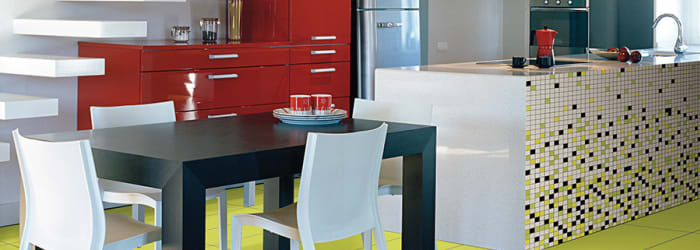let’s highlight some need to know tile flooring installation facts!
Condition of the Surface
In order to install tile correctly you must start from the surface. This is what the tile will be resting on and thus it is important to keep clean, level, and dry. Spend some time examining the surface ensuring that there are not changes in level, no spots of grease or grime, and the surface is dry.
Once the surface is ready for installation, ensure that there is plenty of clearance for the thickness of the tile you have selected under the doors. Most often this is the one mistake homeowners make, and don’t take into account until after the installation is done. Next remove all of the trim around each room as well as anything else that may get in the way of the tile. On an accent wall or backsplash this may include outlet covers, and appliances (if in a kitchen).
Determine the Layout
A common problem concern with tile installation is quality of the installation, unlike any other flooring material tile is extremely difficult to install. It isn’t a job for just anyone. To ensure that each tile turns out straight and perfectly in line with every other tile as well as the wall is a challenge. Which is why the layout you select from the start is crucial. We recommend that you locate the center point of each wall in a given room and create straight lines between each wall intersecting to create a central point in the middle of the room (you can use snap chalk to get these lines).
Tile is laid from the center out, so before beginning installation you should loose lay the tile in one row starting from the center and working towards the wall to see how many you will need and how much of a leftover is required at the end. If you are having a professional install the tile you may want to discuss with them which layout will be best for your room to ensure straight angles and a spectacular look.
Here’s a great resource for how to prepare a tile layout correctly by Hometime.
Do you need a subfloor?
Are you installing tile over a wood surface? Such as on the second floor? If so, you must install a waterproof subfloor… Wooden surfaces will retain moisture and swell during certain seasons, this poses a problem for tile installed directly above. Once the wood swells it shifts the tile above cracking and breaking it. You will need to install a cement board above the wood if this is the case. Make sure you plan for this in your budget as well as discuss your options with your installer. You want a long lasting tile floor that won’t crack or break... your bank included.
Heated or Not?
In the pacific northwest is not uncommon for a homeowner to install an in floor radiant heating system before laying tile. If you are laying tile in an area that is close to a wall that leads outside you will face very cold tile floors during the winter months. Even if the area is not close to the outdoors you will still have colder than normal floors. Stone is generally a material that retains cold for long periods of time and will take long to heat up naturally. Combined with being laid on a poorly insulated surface (directly on concrete) the cold will stay for good.
Many homeowners do not take this into account before installing tile and are forced to suffer for years. Discuss with your installer the cost of having heated tile flooring, and explore your options.
Here’s a great posts outlining the pros and cons of an in floor heating system.
Type of material
Elegance, Durability, and Affordability. The three things every homeowner looking for tile flooring wants. A balance of all three is the golden sweet spot. Depending on the area of installation requires different tile types. For general flooring area we recommend porcelain or ceramic, for backsplashes on the other hand we recommend glass or porcelain mosaic.
For floors porcelain is the most popular option; easy to find in absolutely any color and style, great slip resistant rating, lifetime durability, and affordable costs.







